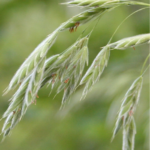Fringed Bromegrass
Bromus ciliatus
General Description
Fringed bromegrass is a tall, loosely tufted, cool season, perennial native bunchgrass. It is found growing native on wet streambanks and lake margins, and in open coniferous or deciduous woodlands and meadows- especially mesic or moist areas. It is effective for erosion control and valued in revegetation mixes for disturbed sites.
Fringed bromegrass is a bunchgrass with fibrous roots. Stems grow to 60 to 100 cm (24 to 39 in) tall, frequently with hairy nodes. Leaves are dark green, 10 cm (4 in) wide and hairy at least on one side. The veining is prominent on both sides of the leaf. It produces some basal growth but mostly leaves up its stem. Seed heads form in open panicles that are 10 to 20 cm (4 to 8 in) long with 4 to 10 long spikelets. Seeds are large and fuzzy when mature in mid-August.
Type
Native grass.
Origin
Native to North America.
Longevity
Less than 5 years. Seed drop prolongs stand lifespan.
Use
Reclamation, pasture. Widely used for reclamation and erosion control. Excellent forage for both ungulate wildlife and livestock as it holds its nutritional value throughout the growing season.
Optimal Time of Use
Summer, fall. Can be grazed throughout the summer and fall seasons as leaves hold their palatability.
Recovery After Use
Fringed bromegrass should be rested for an entire growing season following use. It is considered a decreaser after grazing.
Palatability/Nutritional Value
Excellent palatability for both ungulate wildlife and livestock from emergence through seed set. Plant protein levels average 20% in early June, 9% in July, and 3% in late August to October. In contrast, digestible carbohydrate increases over the growing season. Cattle will strip the leaves off the stems and sheep will seek out and graze the seed heads.
Annual Precipitation min/max (mm)
400mm / 1000mm
Drought Tolerance
Moderate drought tolerance, but is best adapted to moist areas.
Flooding Tolerance
Withstands 1-2 weeks of flooding in the spring. Prefers moist soils thereafter and can be found on subirrigated soils.
Winter Hardiness
High winter hardiness.
Soil Texture Preference
Fringed bromegrass grows best on sandy through clay-loam soils. It is often found growing wet streambanks and lake margins, open coniferous or deciduous woodlands and meadows, especially mesic or moist areas.
Erosion Control
Fringed bromegrass provides excellent erosion control. It is favoured in revegetation mixes for disturbed sites, especially in foothill and boreal forests. Very effective for erosion control. Long term revegetation potential is considered high.
Salinity Tolerance
No tolerance.
Acidity Tolerance
Moderate tolerance.
Alkalinity Tolerance
Low tolerance.
Seeds per kg
301,000 seeds/kg (137,000 seeds/lb)
Suggested Mixtures
Often included in native seeding mixtures as it can establish in shade and open locations. It can compliment longer-living species.
Ease of Establishment
Easily establishes. 85% of seed germinates in 10 to 15 days. Seeds are hairy so can bridge together unless seeded with a carrier.
Competitiveness
Noted for high weed resistance and ability to establish in reclamation situations. Fringed bromegrass does not easily recover after fire. Fringed bromegrass must set seed to remain a major species component in a stand.
Management Considerations
Persistence of fringed bromegrass in a stand is increased if plants are allowed to set seed and establish seedlings. Palatability is high so diligent grazing management should be considered.
USDA FEIS Database, British Columbia Rangeland Seeding Manual, USDA Plants Database
Fringed bromegrass is most suited for dryland range, pasture or reclamation applications where native species are desired in the Sub-Boreal Spruce, Sub-Boreal Pine-Spruce and Interior Cedar-Hemlock zones. It is adapted to wetter areas of the Interior Douglas-fir zone in the southern part of the region.
Fringed bromegrass is most suited to range, pasture or reclamation applications where native species are desired in wetter areas of the Interior Douglas-fir zone and in the Interior Cedar-Hemlock zone.
Fringed bromegrass is found in native plant communities of the Peace-Liard region, locally common in meadows and open forest.
